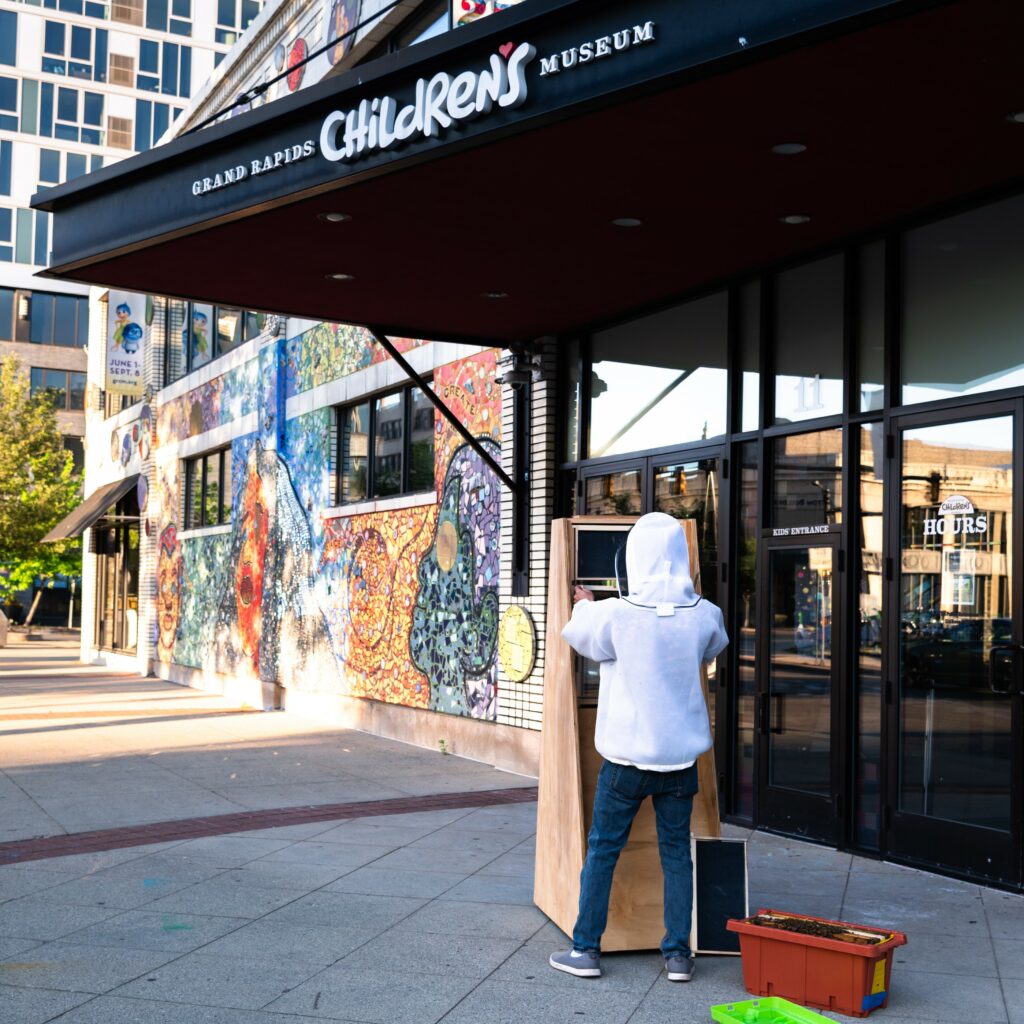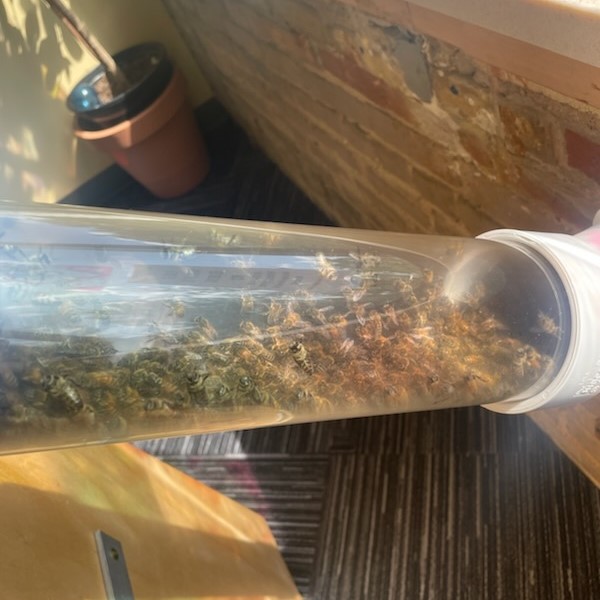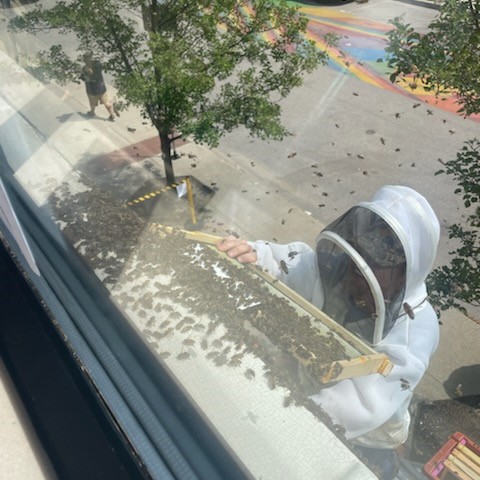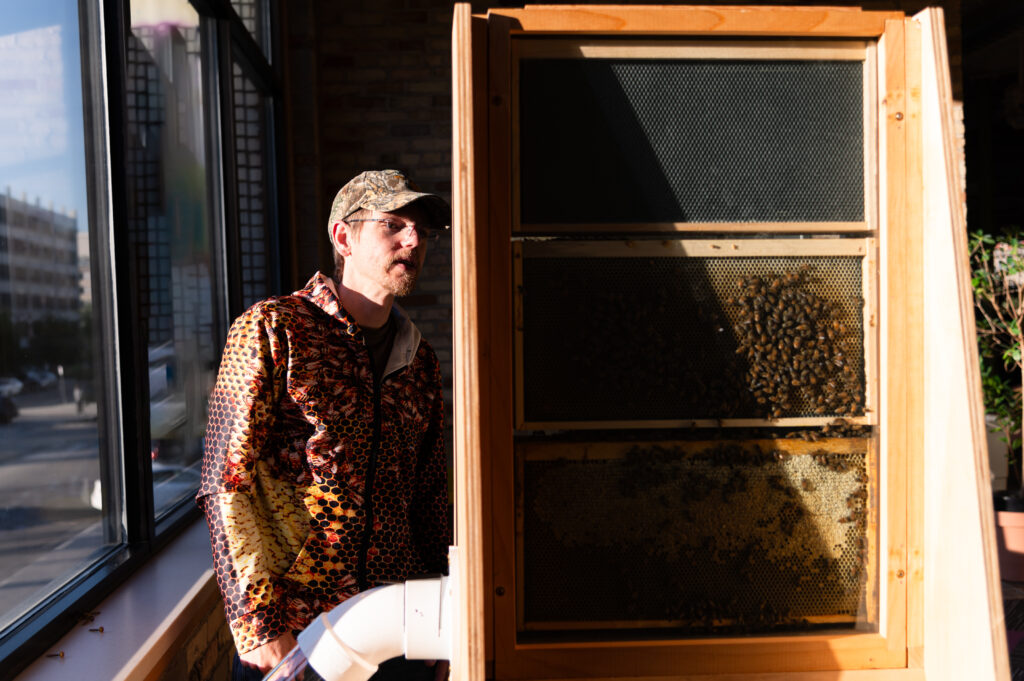In this article contributed by Jeff MacDonald, Director of Facilities and Exhibits at the Grand Rapids Children’s Museum and 2024 Museum EXP Exhibit Professionals Conference Fellow, he shares how the museum was able to restore an active beehive exhibit with the help of local beekeepers.
As the new Director of Facilities and Exhibits for the Grand Rapids Children’s Museum I have learned to embrace challenges that are unique to this role. One of the unique challenges that I have been presented with is the care of a live bee hive. Our museum has a live, glass paneled, bee hive that has a tube connecting it to the outside. This allows the bees to travel outside, collect pollen, make honey and care for their queen as they normally would in the wild. It also gives kids, and adults, an up close and personal view of a functioning bee colony. Guests are able to put their ear to the glass and hear and feel the literal buzz of the hive. They also get to watch the bees dance to communicate, lay eggs, bring in pollen and make honey. This is not something that can safely be observed in the wild, so it is a great learning opportunity for all.
Last summer, my first year with the bees, we had an invasion of beetles in the colony. The beetles were able to completely destroy the colony in a very short time span and despite our best efforts, we were unable to bring the bees back after that. We were determined to bring the bees back this year, but it was time for a completely new bee hive and strategy. I have worked in facilities at various buildings for many years, usually I was removing bees, not creating a safe space for them in our building.
Knowing I needed some outside expertise, I was connected to a local beekeeper group, the Grand Rapids Area Beekeeping Club. Initially I was hoping to get some information or make some connections, but I was blown away by the response. They immediately understood the challenges, and more importantly they understood the mission of the museum and how we were trying to educate the public on the importance of bees. After one meeting a member (who owns a construction company) offered to build a custom hive for our space and donate all of the time and materials. Another member of the group is a local teacher, so he also understood the importance of education in this exhibit. He donated the queen and her colony and comes in once a month to inspect the hive in order to keep it flourishing.
This year the hive was so healthy, and grew so fast, that the bees were preparing to split the colony on their own. A Play Facilitator from our exhibit floor team noticed that the bees were acting strangely in the morning and forming a large ball. Before we knew it, they all took off and swarmed into a tree on our front sidewalk. I was quickly able to get in touch with our beekeeper who explained to me the difference between bees “bearding” and “swarming.” Bearding is when bees all gather in a large cluster at the entrance to the hive to cool the hive down. They use their wings together to push or restrict the airflow into the hive to lower the temperature to their preferred 94 degrees. It is an unusual and unique event to witness up close, so having a beekeeper on the ready was extremely useful for me to learn about this so I could then pass that knowledge down onto our staff and guests. Swarming looks very similar to bearding, but it is when the bees are planning on splitting the colony in half. This happens when the colony is too full for the bees to continue to grow. After communicating with our new beekeeper he determined that the bees were preparing to split the hive. They do that by creating new Queen Cells, which new queen bees will emerge from. The old queen will take half of the colony and start a new hive, which is what leads to the swarming as they prepare.
Our apiarist, expert beekeeper, was able to safely bring the hive outside and open it up. He found the queen just in time before she moved out and was able to show us up close to the new queen that was being developed. I got to observe the beekeeper physically removing the queen and many of her worker bees from the hive. He also took many cells that were full of honey and showed me how they collect that honey and make room for new bees. This allows our hive to have room to grow again and to continue to operate in a way that is healthiest for the bees.
Overall having the The Live Hive Exhibit fall under my department has been one of the most challenging, but most rewarding experiences I have had at the Children’s Museum. I have literally been able to see common honey bees in a completely different way than I see them in nature. I have been able to watch, up close and personal, the life cycle of the worker bee from the egg being laid, to hatching, and growing up and becoming a worker bee. We can see the bees holding little golden balls of pollen and then watch as honey is being made. None of this would have been possible without finding the right partners who not only had the right knowledge and experience, but also the understanding of our core mission and the importance of learning through play.




